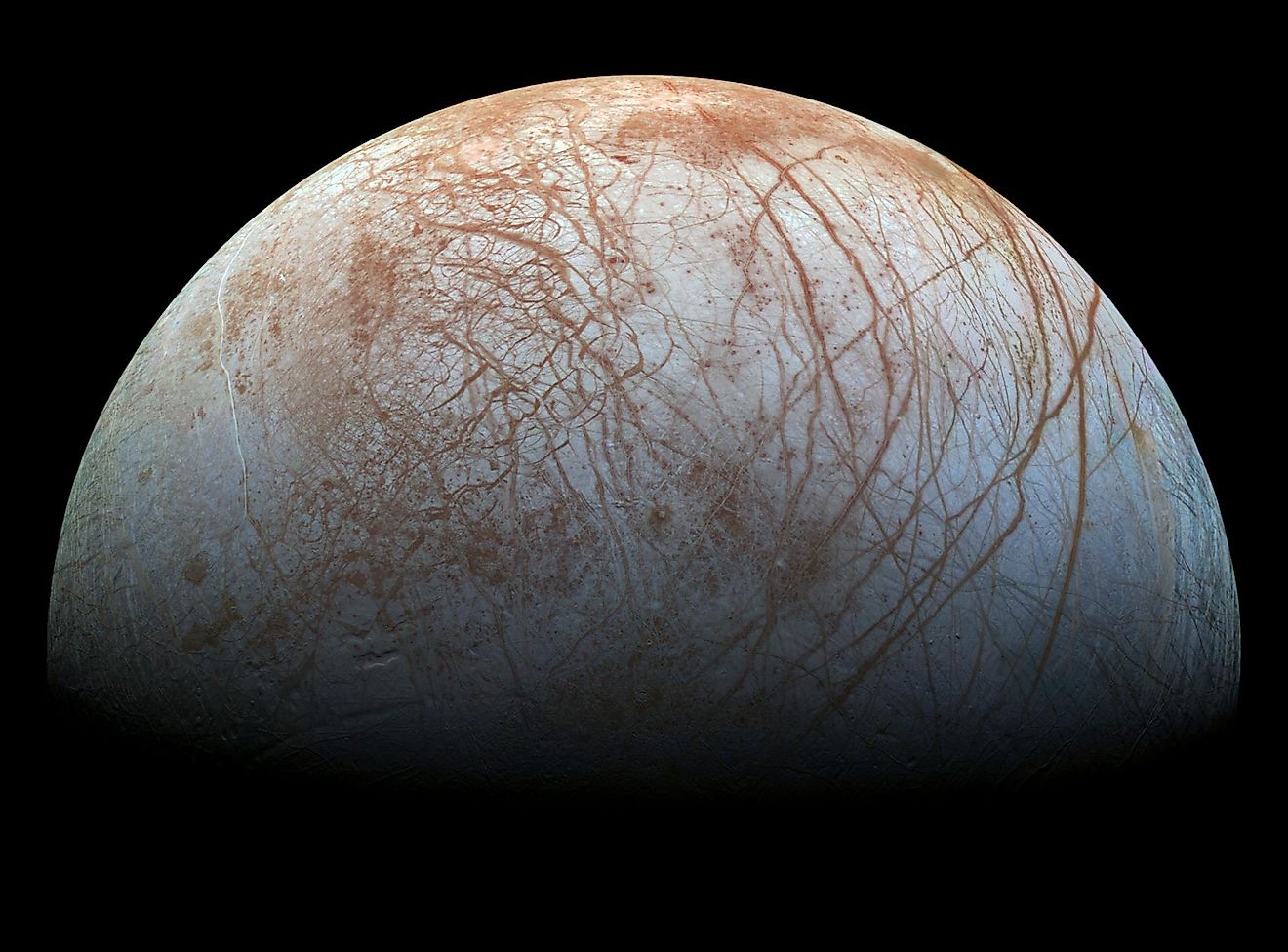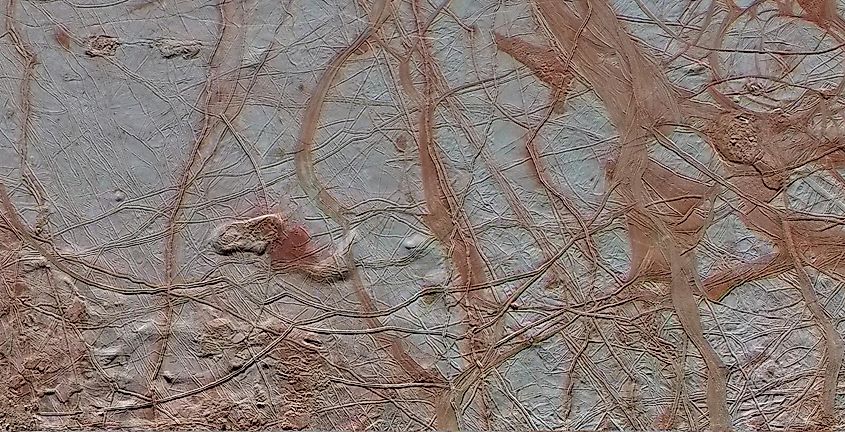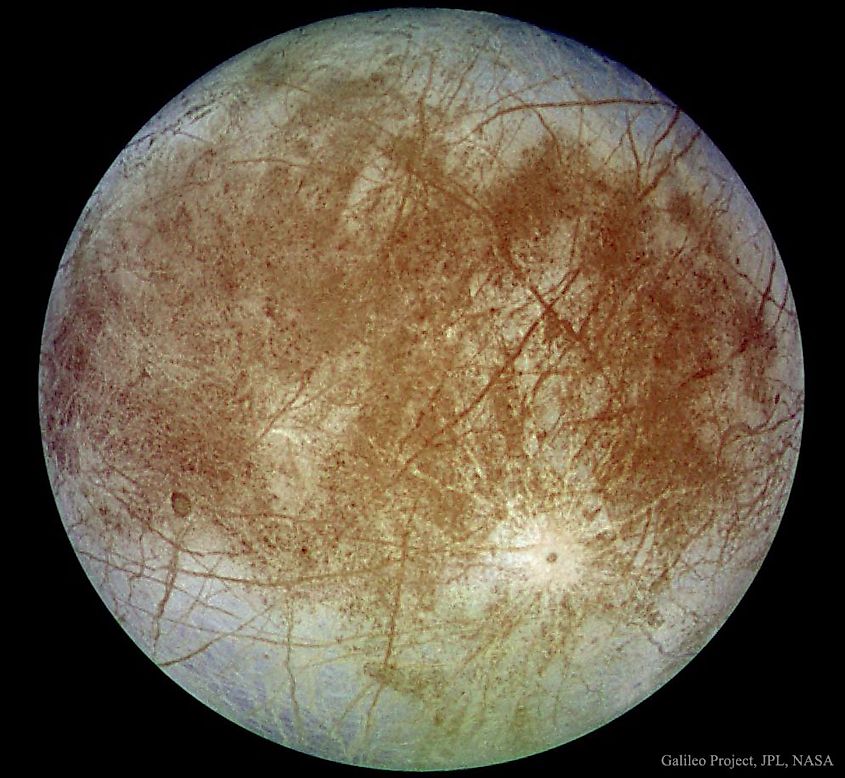Is There Life On Jupiter’s Moon Europa?

- Jupiter’s moon Europa has emerged as the most promising world for finding alien life
- There are three primary conditions for the existence of life: liquid water, organic compounds, and an energy source
- Europa meets every criteria to be defined as habitable
When we think about alien life, we generally think of distant planets around other stars. The search for alien life has generally relied on the search for Earth-like worlds beyond the solar system, yet alien life may actually be a lot closer to home than we think. Although the Earth is currently the only known world to host living organisms, it is not the only habitable environment in the solar system. The solar system boasts a number of worlds that possess the necessary conditions for the existence of life, the most promising of which is Jupiter’s moon, Europa.
Conditions For Life
Before discussing how Europa is habitable, it is important to note the necessary conditions for life to arise. Since Earth life is the only known form of life in the universe, it forms the basis of our scientific understanding of what life requires. There are three primary factors that life requires to arise: organic chemistry, an energy source, and liquid water. First you need the right chemicals, then you need an energy source to start and maintain chemical reactions. Finally, you need liquid water to act as your solvent for the reaction. So long as these three conditions are met, life can potentially arise.
It was once assumed that habitable conditions could only arise within a star’s habitable zone. The habitable zone is defined as the region around a star where, given the right conditions, liquid water can exist on the surface of a planet. However, observations of Europa and other moons have shifted our understanding of habitability. It is possible for worlds outside the habitable zone to develop habitable conditions.
A Moon That Defied Expectations

Europa was first observed by the astronomer Galileo Galilei in 1610. Europa is the smallest of the four Galilean moons of Jupiter, having a diameter of 1,940 miles (3,100 kilometres). For comparison, Earth’s moon is 2,159 miles (3,475 kilometres) in diameter, making Europa only slightly smaller than Earth’s moon. Despite their similarities in size, both moons are vastly different from each other. The first up-close views of Europa came from the Voyager mission, which saw both Voyager 1 and Voyager 2 pass through the Jupiter system and obtain up-close images of Europa’s surface. Astronomers saw a world that defied expectations. It was generally assumed that the moons of the outer solar system would be barren, cratered worlds covered in ice and rock, with little to no evidence of any geologic activity. Europa broke those assumptions. The surface of Europa lacked a large number of impact craters, and perhaps most interesting of all, the surface is covered in large cracks and fissures that stretch across the entire surface. At first, scientists had a difficult time explaining the surface of Europa. Europa looked nothing like any other moon. An explanation soon arose that made Europa one of the most promising worlds for finding alien life.
Europa is covered in a thick layer of icy crust, and the vast cracks and fissures are evidence of that crust breaking apart. Europa is a small, cold world that should not be geologically active, yet the surface shows clear evidence that it is. Generally speaking, small worlds will lose their internal heat faster than larger worlds, and so geologic activity will cease to occur after some time. However, a world can be geologically active if it is being supplied with energy. For example, radioactive decay in the Earth’s interior releases heat energy that keeps the Earth’s interior warm, despite the Earth continuously releasing heat energy into space. In the case of Europa, it is the gravitational pull of Jupiter that supplies the small moon with heat. Europa orbits Jupiter in an ellipse, and so its distance from Jupiter changes throughout its orbit. As the distance between Europa and Jupiter changes, the gravitational pull between them also changes. When Europa is further away, it experiences a weaker gravitational pull. When it’s closer to Jupiter, the gravitational pull becomes stronger. This difference in gravity flexes Europa, compressing and pulling on the moon. This process generates friction within Europa’s core, releasing heat energy that powers geologic activity on the surface. Furthermore, the amount of heat generated melts subsurface ice, forming a subsurface ocean of liquid water. Underneath Europa’s icy crust exists an ocean that is estimated to contain twice as much water as all of Earth’s oceans combined.
Does Europa Have All The Conditions For Life?

Europa has a vast amount of liquid water, one of the essential ingredients for life. Does Europa also possess the other two conditions, an energy source and organics? Interestingly, there is evidence that suggests Europa’s ocean may not be too different from oceans on Earth. Spectral analysis of Europa’s surface has revealed clear evidence that the moon possesses an abundance of organic compounds. Furthermore, there is evidence that the ocean interacts with the seafloor, suggesting that circulation is taking place. Oceanic circulation is an important factor for habitability as it allows for the transfer of energy and chemicals throughout the ocean. Models of Europa’s geology suggest that Europa could be home to hydrothermal vents on its seafloor. On Earth, hydrothermal vents create unique ecosystems that are home to a multitude of different species, and they could have also resulted in the creation of life itself. Hydrothermal vents can also supply the energy source needed for organic chemistry to occur, hence the reason they are one of the leading theories on the origin of life on Earth. Given its similarities to Earth, Europa has emerged as the most promising location for the existence of alien life.
Future Missions To Europa
Current understanding of Europa suggests it possesses all of the necessary conditions for the existence and evolution of life. As of yet, there is no evidence that alien life exists on Europa. To find alien life, we would have to send a space probe capable of drilling through Europa’s icy crust. A kind of submarine would also be required to traverse the subsurface ocean. Thankfully, Europa’s potential habitability has resulted in a lot of attention. There are currently a number of potential missions in development, the most notable of which is called Europa Clipper. In 2015, NASA announced the development of the Europa Clipper mission. Europa Clipper will not be equipped with the ability to land on the surface. Rather, it will orbit Europa, mapping the surface to determine future landing sites. The surface of Europa will be a tremendously difficult place to land, as the surface is covered in sharp ice. Prior to any attempt at landing, scientists must first find regions where a space probe could land successfully. However, there is still a possibility that an orbiter could detect evidence of life. Observations from the Hubble Space Telescope have revealed that Europa is volcanically active. Unlike the volcanoes on Earth, volcanoes on Europa erupt water and ice from the interior into space. An orbiter could fly through some of this ejected ice and look for evidence of any living organisms that so happened to be ejected into space.











